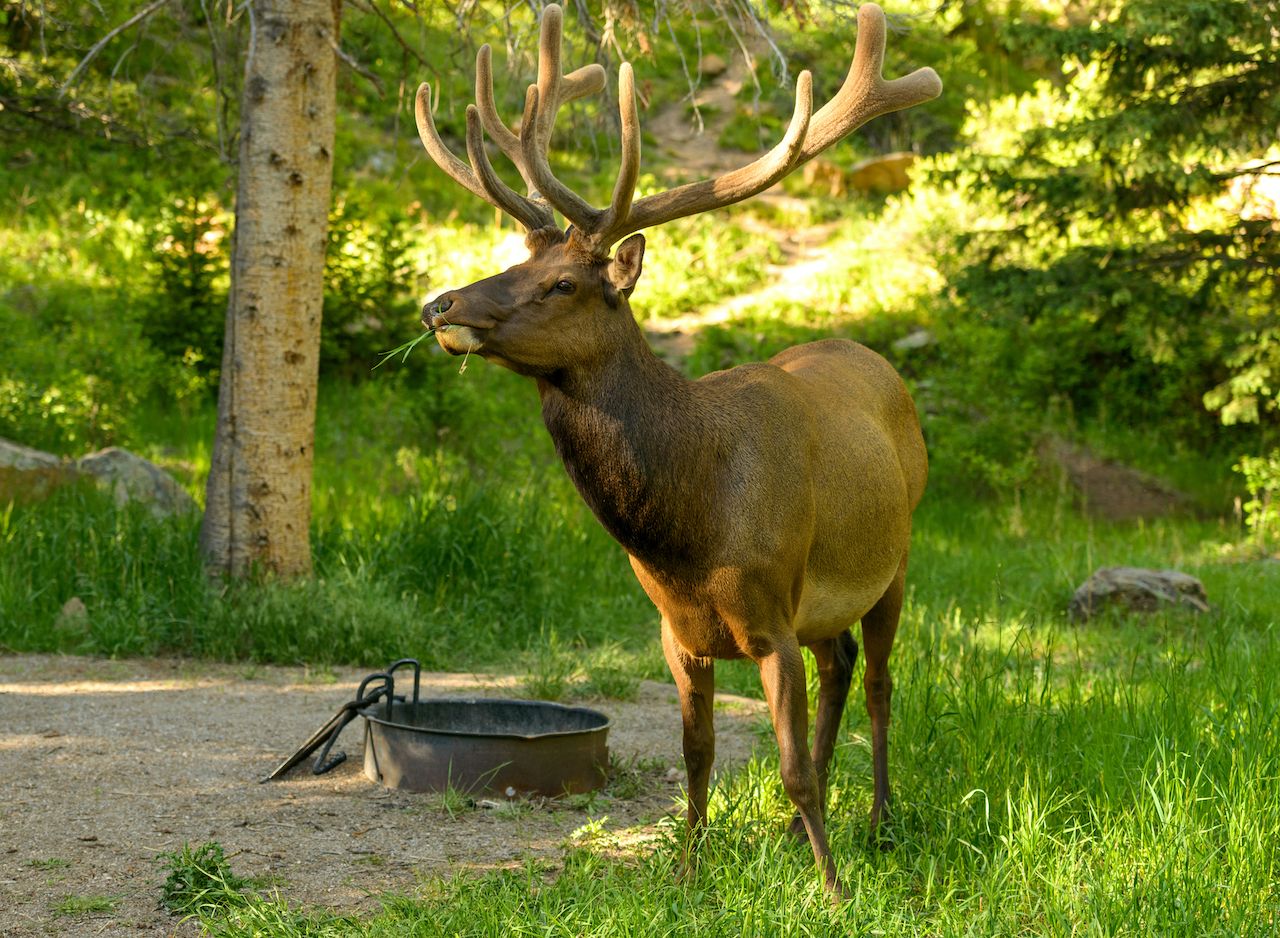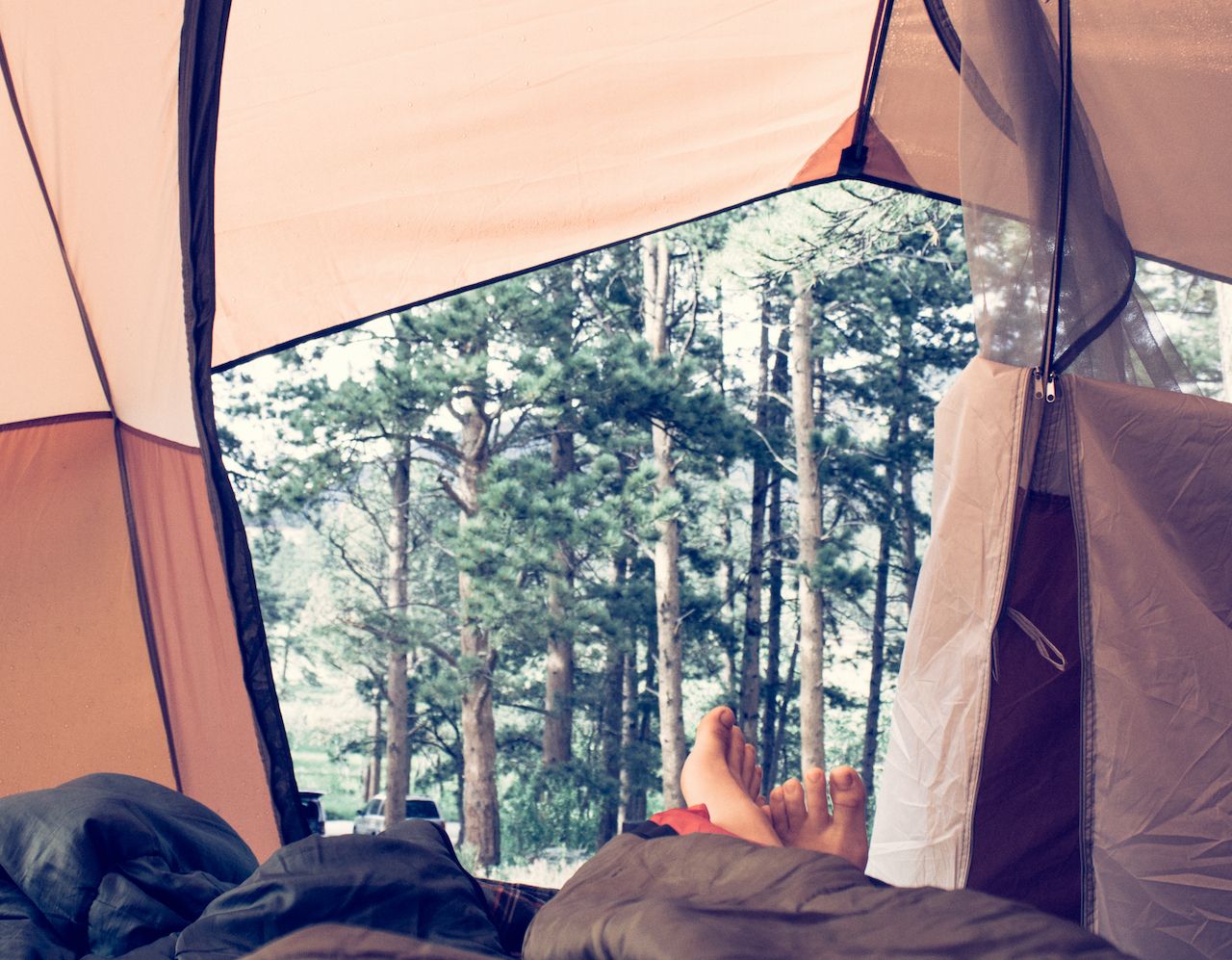There’s nothing like the feeling of truly being present in the wilderness. To experience it, live in a national park — even if just for one night. Camping is the most intimate way to enjoy Rocky Mountain National Park, which immerses you deeper into the high-alpine experience than a simple day trip. Here’s where to do it, both at campgrounds and in the backcountry.
Important things to know
Bear-resistant food containers are required between May and October, and the park will not provide one for you. All food and scented items must be kept 70 adult paces from your site. For a full checklist of items to bring, check out Matador’s backpacking gear recommendations.
Also keep in mind the weather, in terms of what to pack and what plans to make. You’re two miles above sea level, and summer’s night temps often fall into the 40s. Higher elevations can see snow as late as July, so be prepared for wintry weather, regardless of the calendar’s page. For hiking plans, know that summers bring rain and thunderstorms nearly every afternoon. You should plan to be off-trail around 1:00 PM. If trekking above the treeline, better make that noon if clouds are moving in.
Campgrounds
The park has five front-country campgrounds; four of them on the east side of the park. Two are first-come, first-served, usually filling by late morning or early afternoon — although they’ll fill up earlier on weekends. Three are by reservation only via recreation.gov, and it’s best to make them well in advance. You can stay seven nights total, park-wide, each season. Checkout is noon; check-in is at 1:00 PM. Here’s the breakdown, with the first four listed being on the park’s east side.

Photo: Sharon Kilon Han/Shutterstock
Aspenglen Campground — Just a short hop from the Fall River Visitor Center, Aspenglen is, despite its name, surrounded mostly by Douglas firs, lodgepole pines, and ponderosa pines. There are 52 sites, 13 of which are tent-only. In season, which runs late May to late September, potable water, flush toilets, firewood, ice, and food storage lockers are available. RVs are allowed with a maximum of 30 feet. $30/night; reservation only.
Glacier Basin Campground — Glacier Basin sits on the popular Bear Lake Road, near the Sprague Lake area and its many trails. At 8,500 feet, it’s a pleasant mix of open meadows and forest, with 150 sites available; 73 are tent-only. In season, the campground offers flush toilets, potable water, firewood, ice, and food storage lockers. RVs are allowed with a maximum of 35 feet. $30-60/night; reservation only.
Moraine Park Campground — Near the popular Beaver Meadows entrance, Moraine Park is both accessible and beautiful, offering great views of the mountains at 8,160 feet. This is the largest campground in the park by far, with 244 sites, 101 being tent-only. In season, Moraine Park has flush toilets, potable water, firewood, ice, and food storage lockers. RVs are allowed with a maximum of 40 feet. $20-30/night; reservation only in summer, first-come, first-served in winter.

Photo: Sean Xu/Shutterstock
Longs Peak Campground — Twenty miles south of Estes Park near the Longs Peak trailhead, this campground sits up high at 9,500 feet and has 26 tent-only sites. Small and forested, it does have potable water and food storage lockers during the in-season (late June to early September), though vault toilets are available year-round. $30/night; first-come, first-served.
Timber Creek Campground — The only campground on the west side of the park, Timber Creek sits at 8,900 feet near the Colorado River trailhead. Due to a recent mountain pine beetle infestation, there is very little shade. There are 98 campsites, none of which are tent-only. In season (late May to late September), firewood, ice, food storage lockers, potable water, and flush toilets are available. RVs are allowed with a maximum of 30 feet. $30/night; first-come, first-served.
A recent mountain pine beetle infestation requires that all firewood must be purchased from within the park. In season, each campground has its own firewood available for purchase.
Backpacking
The first step to getting almost-lost in Rocky Mountain National Park’s wilderness, and to spending the night in a campground fit for one or two, is to get a wilderness permit for $30. Grab a same-day permit at the Wilderness Office — adjacent to the Beaver Meadows Visitor Center — or at the Kawuneeche Visitor Center. Otherwise, you can obtain one ahead of time at this wilderness permit application website.
There are a whopping 120 backcountry campsites to choose from, so you’ve got your research cut out for you. They differ in many ways, large and small. Some have privies, some do not. Many have just one or two sites. The largest, Boulderfield (site 44, on the way up to Longs Peak), has nine. Some are just a mile or so away from the nearest trailhead, some are nearly a ten-mile trek.
All are worthy of your hours (and the calorie-burn), but here are some recommendations:
Ouzel Lake (56) — Veteran backpackers will likely enjoy the area around Ouzel Lake, in the lesser-visited Wild Basin region. It sits at 10,020 feet, has no privy, and is a 4.9-mile, 1,520-foot upward climb in. Here, Bluebird Lake sits a thousand feet above you; it’s a strenuous day hike from your site. Or you could just relish your solitude in one the quietest areas of the park and simply be. Most who hike this way turn around at Ouzel Falls and Calypso Cascades.

Photo: Katie Kirkland/Shutterstock
Fern Lake (28) — For a bit of a challenge — one fit for newbie backpackers or those with older children — check out Fern Lake. It’s 3.8 miles and a 1,380-foot climb to the campsite, where, yes, there are privies and plenty to do. You’ll be near many waterfalls and lakes, including Spruce, Odessa, and Helene, and at night the stars will keep you good company before early-morning sunrises and day hikes. Start from the Fern Lake Trailhead, near the Moraine Park Campground.

Photo: Sharon Kilon Han/Shutterstock
Andrews Creek (40) — If you’re looking to commune with some serious wilderness, and you’re willing to carry out your #2, check out Andrews Creek. You’ll take the Glacier Gorge trailhead past roaring waterfalls, wind to the right of The Loch, wander groves of white aspen and fields of pink boulders, finally ending at your tiny site — it’s just you — 10,560 feet in the sky. Andrews Creek, bubbling with glacial meltwater, runs right by. Nearby sites include Sky Pond, Timberline Falls, and Andrews Glacier.
The Tonahutu Creek Loop Trail (69-94) — The above sites could all be part of a bigger, grander trek, but the Tonahutu Creek Loop warrants mentioning. It’s the only trek on this list on the true western side of the park. It starts near Grand Lake and climbs to the Continental Divide trail. Start at the Tonahutu/North Inlet trailhead, and wander into the park for 3-5 days, with the trek to Flattop Mountain as an option. You’ll have over 26 miles to sit at lake edges, count the hooves of moose and elk, and see the trees transfigured in every shade of the sunset.